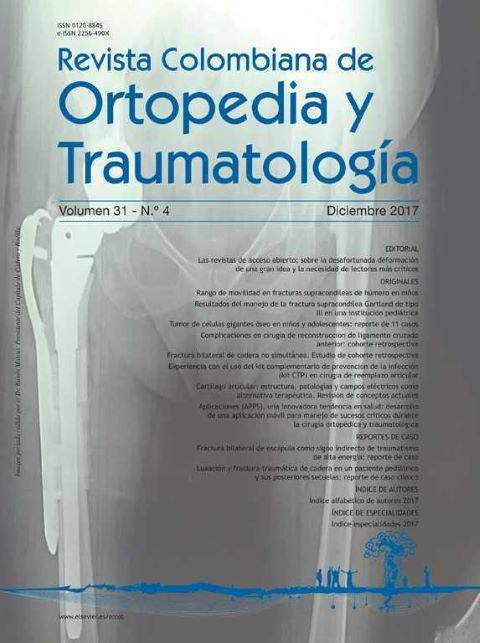Outcomes in the management of Gartland III supracondylar fracture in a paediatric institution
DOI:
https://doi.org/10.1016/j.rccot.2017.06.010Keywords:
supracondylar fractures, treatment, nerve injuryAbstract
Background: Supracondylar fractures are the most common elbow fracture described in children. Different types of fixation, including cross- and side-pin fixations, have been described and compared. However, there is still controversy about which of the two techniques provides better stability and results. The iatrogenic injury of the ulnar nerve is a known complication of the medial pin compared to the side pins placement.
Materials and methods: An evaluation was made of a retrospective cohort of patients diagnosed with Gartland III supracondylar fractures. The aim was to compare post-operative neurological injuries in patients treated with cross pin vs. side pins.
Results: A total of 141 patients were included, of whom 61% were boys. Closed reduction was performed in 96.5% of the cases, and crossed nail fixation was used in 78.7% of them. The post-operative diagnosis classification changed from Gartland III to IV in 18.4% of the cases. Post-operative nerve injury was present in 12.8% of patients, with the ulnar nerve being the most affected (61.1%). There were no statistically significant differences between the groups
with and without neurological injury.
Discussion: The incidence of iatrogenic ulnar nerve injuries after crossed pins fixation has been reported in the literature to be as high as 15%, which was similar to the one found in our study (12.8%). Elbow flexion -necessary to maintain the fracture reduction, as well as elbow oedema are known factors for the injury of the ulnar nerve. The injury of the ulnar nerve should be avoided at all costs during the osteosynthesis with crossed pins. Therefore, the technique described by Dorgan is recommended, which uses a minimal medial incision and exploration of the ulnar nerve before the osteosynthesis with nails is performed.
Evidence level: III.
Downloads
References
Abzug JM, Herman MJ. Management of supracondilar humerus fractures in children: Currents concepts. J Am Acad Orthop Surg. 2012;20:69-77. https://doi.org/10.5435/00124635-201202000-00002
Omid R, Choi PD, Skaggs DL. Supracondylar humeral fractures in children. J Bone Joint Surg. 2008;90:1121-32. https://doi.org/10.2106/JBJS.G.01354
Zaltz I, Waters PM, Kasser JR. Ulnar nerve instability in children. J Pediatr Orthop. 1996;16:567-9. https://doi.org/10.1097/01241398-199609000-00003
Wind WM, Schwend RM, Armstrong DG. Predicting ulnar nerve location in pinning of supracondylar humerus fractures. J Pediatr Orthop. 2002;22:444-7. https://doi.org/10.1097/01241398-200207000-00006
Zionts LE, McKellop HA, Hathaway R. Torsional strength of pin configurations used to fix supracondylar fractures of the humerus in children. J Bone Joint Surg Am. 1994;76:253-6. https://doi.org/10.2106/00004623-199402000-00013
Lee SS, Mahar AT, Miesen D, Newton PO. Displaced pediatric supracondylar humerus fractures: Biomechanical analysis of percutaneous pinning techniques. J Pediatr Orthop. 2002;22:440-3. https://doi.org/10.1097/01241398-200207000-00005
Sankar WN, Hebela NM, Skaggs DL, Flynn JM. Loss of pin fixation in displaced supracondylar humeral fractures in children: Causes and prevention. J Bone Joint Surg Am. 2007;89: 713-7. https://doi.org/10.2106/JBJS.F.00076
Larson L, Firoozbakhsh K, Passarelli R, Bosch P. Biomechanical analysis of pinning techniques for pediatric supracondylar humerus fractures. J Pediatr Orthop. 2006;26:573-8. https://doi.org/10.1097/01.bpo.0000230336.26652.1c
Royce RO, Dutkowsky JP, Kasser JR, Rand FR. Neurologic complications after K-wire fixation of Supracondylar humerus fractures in children. J Pediatr Orthop. 1991;11:191-4. https://doi.org/10.1097/01241398-199103000-00010
Agus H, Kelenderer O, Kayali C. Closed reduction and percutaneous pinning results in children with supracondylar humerus fractures. Acta Orthop Traumatol Turc. 1999;33:18-22.
Skaggs DL, Hale JM, Bassett J, Kaminsky C, Kay RM, Tolo VT. Operative treatment of supracondylar fractures of humerus in children, The consequences of pin placement. J Bone Joint Surg Am. 2001;83:735-40. https://doi.org/10.2106/00004623-200105000-00013
Shannon FJ, Mohan P, Chacko J, D'Souza LG. ''Dorgan's' percutaneous lateral cross-wiring of supracondylar fractures of humerus in children. J Pediatr Orthop. 2004;24:376-9. https://doi.org/10.1097/01241398-200407000-00006
Downloads
Published
How to Cite
Issue
Section
License
Copyright (c) 2024 Revista Colombiana de ortopedia y traumatología

This work is licensed under a Creative Commons Attribution 3.0 Unported License.




